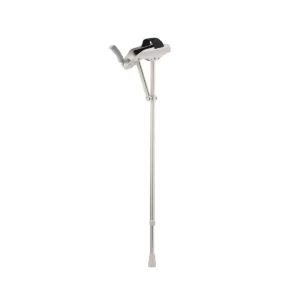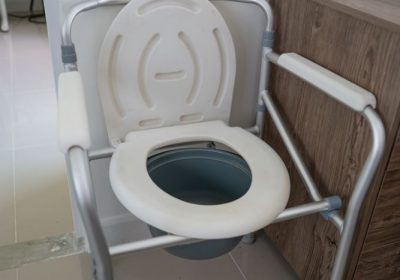Forearm Crutches
Brief explanation of what forearm crutches are
Forearm crutches, also known as elbow crutches, are a type of mobility aid designed to assist people with limited mobility in their lower extremities. They consist of two vertical shafts, typically made of lightweight aluminum or carbon fiber, with a padded cuff that fits around the forearm and a handgrip at the top.
The cuff is designed to rest on the forearm, while the handgrip is used to provide support and stability while walking or standing. Forearm crutches are adjustable in height, allowing users to customize the fit to their specific needs.
Forearm crutches are commonly used by individuals with injuries or disabilities affecting the lower extremities, such as fractures, sprains, or paralysis. They can also be used by people with conditions that cause weakness or pain in the legs, such as arthritis or multiple sclerosis.
Unlike traditional underarm crutches, which can be uncomfortable and restrictive, forearm crutches are designed to be more ergonomic and comfortable to use, as they distribute the weight of the body more evenly across the forearm. They also allow for greater freedom of movement and the ability to use one’s hands more easily, making them a popular choice for people who require long-term mobility assistance.
Why they are necessary for some individuals
Forearm crutches are necessary for some individuals who have limited mobility in their lower extremities, and they may not be able to walk or stand without assistance. Here are some of the reasons why forearm crutches are necessary for some individuals:
- Injuries: Individuals who have sustained injuries to their legs, such as fractures or sprains, may need to use forearm crutches while they heal. This is because the crutches help to take weight off the injured leg, allowing it to heal faster and preventing further damage.
- Disabilities: People with disabilities that affect their ability to walk or stand may also require the use of forearm crutches. For example, individuals with cerebral palsy, multiple sclerosis, or muscular dystrophy may have weakness or spasticity in their legs, making it difficult to walk without support.
- Chronic conditions: Some chronic conditions, such as arthritis or degenerative disc disease, can cause pain or weakness in the legs, making it difficult to walk or stand for extended periods. Forearm crutches can provide support and stability, allowing these individuals to move around more comfortably.
- Post-surgery: After surgery on the lower extremities, such as knee or hip replacement, individuals may need to use forearm crutches temporarily while they recover and regain strength and mobility.
Types of Forearm Crutches
Explanation of the different types of forearm crutches
There are several types of forearm crutches available on the market, each with its own unique features and benefits. Here are the most common types of forearm crutches:
- Standard Forearm Crutches: These are the most basic type of forearm crutches, consisting of two vertical shafts, a padded cuff that fits around the forearm, and a handgrip at the top. They are adjustable in height and are typically made of lightweight aluminum or carbon fiber.
- Platform Forearm Crutches: These crutches have a platform at the top, rather than a handgrip, which can be helpful for individuals who have difficulty gripping or have limited hand strength. The platform provides a larger surface area for the user to rest their hand or forearm.
- Folding Forearm Crutches: These crutches are designed to be easily collapsible for storage or transport, making them a convenient option for individuals who need to take their crutches on the go. They typically have a button or lever that allows them to be folded down quickly.
- Articulated Forearm Crutches: These crutches have a hinge mechanism at the cuff, which allows the user to move their arm more freely while walking. This can be particularly helpful for individuals who need to reach for objects or perform other tasks while using the crutches.
- Ergonomic Forearm Crutches: These crutches are designed to be more comfortable and ergonomic, with a contoured cuff and handgrip that fit the natural shape of the user’s arm and hand. This can help to reduce discomfort or fatigue during extended use.
- Bariatric Forearm Crutches: These crutches are designed to support individuals who are heavier or larger in size, with a higher weight capacity and wider cuffs and shafts.
Benefits and drawbacks of each type
Here are the benefits and drawbacks of each type of forearm crutches:
- Standard Forearm Crutches: Benefits: Lightweight, affordable, easily adjustable Drawbacks: Basic design may not be comfortable for extended use, handgrip can be slippery
- Platform Forearm Crutches: Benefits: Larger surface area for resting the forearm, helpful for individuals with limited hand strength or dexterity Drawbacks: Limited handgrip options, can be bulky and less portable
- Folding Forearm Crutches: Benefits: Easy to store and transport, convenient for individuals on the go Drawbacks: May not be as sturdy as non-folding crutches, may require more frequent maintenance due to moving parts
- Articulated Forearm Crutches: Benefits: Allows for greater freedom of movement, can be helpful for individuals who need to reach for objects or perform tasks while using the crutches Drawbacks: May be more expensive, more complex design may be more difficult to adjust or maintain
- Ergonomic Forearm Crutches: Benefits: More comfortable and ergonomic design, can reduce discomfort or fatigue during extended use Drawbacks: More expensive, may not be available in all sizes or weight capacities
- Bariatric Forearm Crutches: Benefits: Designed to support larger individuals, with a higher weight capacity and wider cuffs and shafts Drawbacks: May be heavier or less portable, may be more expensive than standard crutches
Choosing the Right Crutches
Factors to consider when choosing forearm crutches, such as height and weight capacity
When choosing forearm crutches, there are several factors to consider to ensure that the crutches are safe, comfortable, and effective. Here are some of the most important factors to keep in mind:
- Height: Forearm crutches should be adjusted to the appropriate height for the user’s height and arm length. This helps to ensure proper weight distribution and reduce the risk of strain or injury. Most crutches are adjustable in height, so be sure to choose a model that can accommodate the user’s height.
- Weight capacity: Forearm crutches are typically rated for a maximum weight capacity. It is important to choose crutches that can safely support the user’s weight, as using crutches that are not rated for their weight can lead to instability, discomfort, or injury.
- Material: Forearm crutches are available in a variety of materials, including aluminum, carbon fiber, and steel. Aluminum crutches are lightweight and durable, while carbon fiber crutches are even lighter and more flexible. Steel crutches are heavier but can support higher weight capacities.
- Cuff and handgrip design: The cuff and handgrip should be comfortable and provide a secure grip. Some crutches have contoured cuffs and handgrips that fit the natural shape of the user’s arm and hand, while others have adjustable cuffs that can be customized for a better fit.
- Portability: If the user needs to take their crutches on the go, portability is an important factor to consider. Folding crutches can be easier to store and transport, while non-folding crutches may be sturdier and more durable.
- Additional features: Some forearm crutches have additional features, such as platform handgrips, articulating cuffs, or shock-absorbing tips. These features can provide added comfort or functionality, but may also increase the cost of the crutches.
How to properly measure for crutches
Properly measuring for crutches is important to ensure that they fit well and provide the necessary support for the user. Here are the steps to follow to measure for crutches:
- Stand upright with shoes on and arms relaxed at your sides.
- Have someone measure the distance from the floor to the armpit, with the arm slightly bent at the elbow. This measurement will determine the overall height of the crutches.
- Next, have someone measure the distance from the floor to the user’s wrist when the arm is bent at a 90-degree angle. This measurement will determine the distance from the handgrip to the cuff of the crutch.
- To measure the cuff width, measure the circumference of the user’s forearm at the widest point.
- Finally, measure the distance from the tip of the user’s elbow to the floor to determine the appropriate length of the crutch shaft.
Once these measurements have been taken, it is important to choose crutches that can be adjusted to fit these dimensions. Many crutches are adjustable in height, handgrip to cuff distance, and cuff width. It is also important to ensure that the crutches can support the user’s weight.
Proper fit is crucial for comfortable and effective use of crutches. Poorly fitting crutches can lead to discomfort, instability, or even injury. It is important to take the time to measure properly and choose crutches that can be adjusted to fit the user’s unique dimensions.
How to Use Forearm Crutches
Step-by-step instructions for using forearm crutches properly
Using forearm crutches properly is important to ensure safety, comfort, and effective support. Here are step-by-step instructions for using forearm crutches properly:
- Adjust the crutches to the appropriate height. The handgrips should be at hip level, and the cuffs should be about one to two inches below the back of the elbow.
- Place the cuffs around the forearms, with the handgrips in the hands.
- Stand upright with feet shoulder-width apart and the crutches slightly in front of the body.
- To move forward, step forward with the injured or weaker leg, keeping the crutches stable. Then, shift the weight onto the crutches and step forward with the stronger leg.
- To go up stairs, approach the stairs and place both crutches on the step above. Then, step up with the good foot, followed by the injured or weaker foot. To go down stairs, place the crutches on the step below and step down with the injured or weaker foot first, followed by the stronger foot.
- To turn, pivot on the good foot, keeping the injured or weaker foot behind.
- To sit down, back up to the chair until it touches the back of the legs. Place both crutches together in one hand, and use the other hand to grasp the armrests of the chair. Slowly lower the body onto the seat.
- To stand up from a chair, place both crutches together in one hand and push up from the seat with the other hand. Once standing, take hold of the crutches again.
- When walking, swing the crutches forward and place them on the ground, followed by the injured or weaker foot, and then the stronger foot.
- Always ensure that the crutches are securely placed on the ground before putting weight on them.
These are the basic steps for using forearm crutches properly, but it is important to follow the specific instructions given by a healthcare professional or physical therapist. Proper use of forearm crutches can help individuals move around safely and effectively while recovering from an injury or disability.
Tips for maintaining balance and avoiding falls
When using forearm crutches, maintaining balance is important to avoid falls and further injury. Here are some tips for maintaining balance and avoiding falls while using forearm crutches:
- Keep the crutches close to the body: The crutches should be kept close to the body to provide stability and support. Avoid holding the crutches too far out from the body, as this can lead to instability.
- Look ahead: When walking, look ahead instead of down at the feet or crutches. This helps to maintain balance and avoid obstacles.
- Take small steps: Taking small steps can help maintain balance and prevent tripping or falling. It is important to avoid taking big steps or trying to move too quickly.
- Wear appropriate footwear: Wear comfortable, well-fitting shoes with good traction. Avoid wearing high heels, sandals, or shoes with slippery soles, as these can increase the risk of falls.
- Avoid carrying heavy objects: Carrying heavy objects while using crutches can throw off balance and increase the
Benefits of Forearm Crutches
Explanation of how forearm crutches can improve mobility and independence
Forearm crutches are a mobility aid that can greatly improve mobility and independence for individuals who have difficulty walking due to injury, disability, or weakness. Here are some ways that forearm crutches can improve mobility and independence:
- Increased stability: Forearm crutches provide a stable base of support, helping individuals to maintain balance and reduce the risk of falls. This increased stability allows individuals to move around more confidently and safely, improving their independence and mobility.
- Reduced weight bearing: Forearm crutches can help to reduce the amount of weight bearing on the legs and feet, which can be helpful for individuals who have pain or weakness in their lower extremities. By transferring some of the weight to the upper body, individuals can move around more comfortably and with less strain on their legs and feet.
- Improved posture: Using forearm crutches can help to improve posture, which can be especially important for individuals with back or spinal problems. The crutches provide support for the upper body, helping to keep the spine in a more neutral position.
- Increased range of motion: Forearm crutches allow individuals to move around more freely, which can help to increase their range of motion and improve overall mobility. This increased mobility can help individuals to participate in activities that they might otherwise be unable to do.
- Greater independence: By providing increased stability and mobility, forearm crutches can help individuals to be more independent and self-sufficient. This can be especially important for individuals who may have difficulty with activities of daily living such as cooking, cleaning, or shopping.
Comparison to other mobility aids, such as walkers and canes
While forearm crutches are a popular mobility aid, there are other options available as well, including walkers and canes. Here is a comparison of forearm crutches to other mobility aids:
- Walkers: Walkers are a mobility aid that provide a stable base of support and often include a seat and storage area. While walkers can provide more stability than crutches, they can be more cumbersome and difficult to maneuver. Walkers are often used by individuals who require more support or who have difficulty maintaining balance.
- Canes: Canes are a mobility aid that provide support for individuals with mild balance issues or weakness in one leg. Canes can be more portable and easier to use than crutches, but they provide less stability and support. Canes are often used by individuals who require minimal support.
- Forearm crutches: Forearm crutches provide a stable base of support and are designed to transfer weight to the upper body, reducing strain on the legs and feet. They are more portable and easier to use than walkers, but provide more support than canes. Forearm crutches are often used by individuals who require moderate support.
Drawbacks of Forearm Crutches
Explanation of the potential drawbacks of using forearm crutches, such as discomfort and fatigue
While forearm crutches can be a valuable mobility aid for individuals with walking difficulties, there are potential drawbacks to using them as well. Here are some of the potential drawbacks of using forearm crutches:
- Discomfort: Using forearm crutches can cause discomfort in the wrists, hands, and arms, especially if the crutches are not properly adjusted or if they are used for extended periods of time. Individuals may also experience soreness or irritation in the armpits from the pressure of the crutches.
- Fatigue: Using forearm crutches can be tiring, especially if the individual is not used to using them or if they have to use them for extended periods of time. This can lead to muscle fatigue in the arms and upper body.
- Limited mobility: While forearm crutches can improve mobility, they can also limit mobility in certain situations, such as on stairs or in tight spaces. Individuals may also have difficulty carrying objects while using crutches.
- Social stigma: Some individuals may feel self-conscious or embarrassed about using forearm crutches, which can impact their confidence and willingness to use them in public.
- Cost: Forearm crutches can be expensive, and insurance may not cover the full cost. This can make them inaccessible to some individuals.
Despite these potential drawbacks, forearm crutches can be a valuable mobility aid for individuals with walking difficulties. With proper adjustment and use, individuals can minimize discomfort and fatigue and enjoy the benefits of improved mobility and independence.
Tips for minimizing discomfort
While forearm crutches can be a helpful mobility aid, they can also cause discomfort if they are not properly adjusted or used. Here are some tips for minimizing discomfort when using forearm crutches:
- Adjust the height: The height of the crutches should be adjusted so that the top of the crutches are about one to two inches below the armpits, and the handgrips are at hip level. This can help to prevent pressure on the armpits and reduce discomfort in the wrists and hands.
- Use padding: Adding padding to the handgrips and underarm rests can help to reduce discomfort and pressure on the hands, wrists, and armpits.
- Wear appropriate clothing: Wear loose-fitting clothing to prevent rubbing and irritation on the skin. Avoid wearing bulky jackets or coats that can interfere with the use of the crutches.
- Use proper technique: Using proper technique when walking with crutches can help to reduce discomfort and fatigue. Lean forward slightly and place the crutches about one foot in front of you, then step forward with the affected leg.
- Take breaks: Taking breaks and resting the arms and upper body can help to reduce fatigue and discomfort. If possible, switch to a different mobility aid or take a break from walking altogether.
By following these tips, individuals can minimize discomfort when using forearm crutches and enjoy the benefits of improved mobility and independence. It is also important to speak with a healthcare professional if discomfort persists or if there are concerns about the proper use of the crutches.
Caring for Forearm Crutches
How to clean and maintain forearm crutches
Regular cleaning and maintenance of forearm crutches can help to extend their lifespan and ensure they continue to function properly. Here are some tips for cleaning and maintaining forearm crutches:
- Clean the handgrips and underarm rests: Use a damp cloth or disinfectant wipe to clean the handgrips and underarm rests after each use to prevent the buildup of dirt and bacteria.
- Check the tips: The tips of the crutches can become worn or damaged over time, which can affect stability and grip. Check the tips regularly and replace them if they are worn or damaged.
- Tighten bolts and screws: Check the bolts and screws on the crutches regularly and tighten them if they become loose. Loose bolts and screws can affect stability and safety.
- Store properly: Store the crutches in a dry, cool place when not in use to prevent rust and corrosion.
- Replace worn parts: Over time, the handgrips, underarm rests, and other parts of the crutches may become worn or damaged. Replace these parts as needed to ensure the crutches continue to function properly.
- Avoid exposure to extreme temperatures: Extreme temperatures can affect the material and durability of the crutches. Avoid leaving them in a hot car or exposing them to extreme cold temperatures.
By following these tips for cleaning and maintaining forearm crutches, individuals can ensure they continue to function properly and provide the support and mobility needed for daily activities.
When to replace crutches
Like any mobility aid, forearm crutches can wear out over time and may need to be replaced. Here are some signs that it may be time to replace crutches:
- Visible wear and tear: Check the crutches for any signs of visible wear and tear, such as cracks or breaks in the material, loose bolts or screws, or worn-out handgrips and underarm pads.
- Difficulty adjusting: If the crutches are difficult to adjust or keep slipping out of the desired position, it may be time to replace them.
- Persistent discomfort: If the individual experiences persistent discomfort, pain, or fatigue when using the crutches, despite adjustments and proper use, it may be time to replace them.
- Changes in mobility needs: If the individual’s mobility needs change, such as if they require a different height or weight capacity, it may be necessary to replace the crutches.
- Age of the crutches: If the crutches are old and have been in use for several years, it may be time to replace them to ensure optimal safety and function.
It is important to speak with a healthcare professional before replacing crutches, as they can provide guidance on the appropriate type and fit of crutches needed based on the individual’s specific needs and mobility limitations. By staying aware of signs that it may be time to replace crutches and working with a healthcare professional, individuals can ensure they have the right mobility aid to support their daily activities and maintain their independence.
Conclusion
Summary of the benefits and drawbacks of using forearm crutches
Forearm crutches are a mobility aid that can provide individuals with increased independence and support when walking or standing. Here is a summary of the benefits and drawbacks of using forearm crutches:
Benefits:
- Provide increased support and stability when walking or standing
- Allow for greater mobility and independence
- Can be adjusted to fit an individual’s height and weight for optimal comfort
- Lightweight and portable, making them easy to transport
- Can help reduce pressure on the legs and lower back, making them ideal for individuals with certain injuries or disabilities
Drawbacks:
- Can cause discomfort or fatigue with prolonged use
- May require some practice to use correctly and maintain balance
- May limit an individual’s ability to carry objects while using the crutches
- May not be suitable for individuals with certain upper body or hand strength limitations
- May not provide enough support for individuals with severe mobility limitations
Overall, the benefits of using forearm crutches can outweigh the drawbacks for many individuals, particularly those with mild to moderate mobility limitations. It is important to speak with a healthcare professional to determine if forearm crutches are the right mobility aid for an individual’s specific needs and to receive guidance on proper use and maintenance.
Final thoughts and advice for individuals considering forearm crutches as a mobility aid.
If you are considering using forearm crutches as a mobility aid, there are a few final thoughts and pieces of advice to keep in mind:
- Speak with a healthcare professional: Before using forearm crutches, it is important to speak with a healthcare professional to determine if they are the right mobility aid for your specific needs. They can also provide guidance on proper use, adjustment, and maintenance.
- Practice proper technique: Using forearm crutches requires some practice to ensure proper technique and balance. Take the time to practice using the crutches and ask a healthcare professional for guidance if needed.
- Choose the right size and weight capacity: Forearm crutches come in different sizes and weight capacities. Choose a pair that is the right size for your height and weight to ensure optimal comfort and support.
- Consider other mobility aids: While forearm crutches can be a great mobility aid for many individuals, they may not be the best choice for everyone. Consider other options such as walkers, canes, or wheelchairs to determine which mobility aid will best suit your needs.
- Maintain your crutches: Proper maintenance of your crutches can help extend their lifespan and ensure they continue to function properly. Clean them regularly and replace any worn or damaged parts as needed.
By following these tips and speaking with a healthcare professional, you can determine if forearm crutches are the right mobility aid for you and ensure proper use and maintenance for optimal support and independence.
Image Source:
Forearm Crutches – The Rebotec ECO 120 – MyMedici











